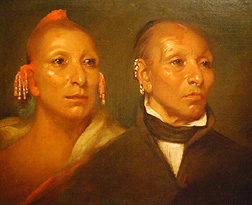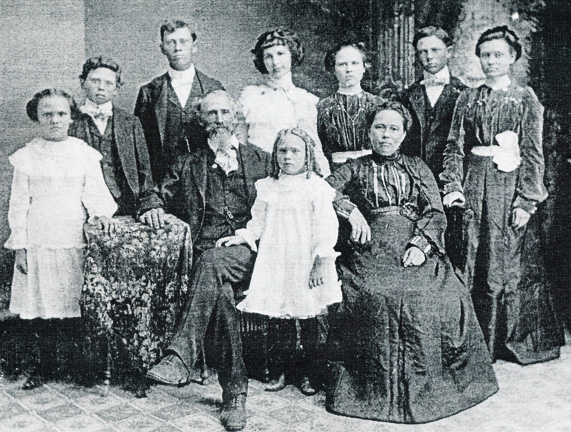

Home About Travel History Genealogy Resources
Americana Journeys - Genealogy
NATIVE AMERICAN HERITAGE – A MYSTERY
Cherokee Trail or Black Hawk War
Family Legend
 Like
many American families, one of our common apocryphal legacies was that
we were told our heritage was part Cherokee. I took this to be
true for a long portion of my life, but after gaining an interest in
genealogy and the passing of older generations, this family legend
has come into both a fuzzy dubious connection and a sharper focus.
I still fully believe the Native American part and believe I have some
evidence to support it, but it’s the Cherokee part that doesn’t
quite seem to fit the facts. At some point the Cherokee turned into
Cherokee or Choctaw.
Like
many American families, one of our common apocryphal legacies was that
we were told our heritage was part Cherokee. I took this to be
true for a long portion of my life, but after gaining an interest in
genealogy and the passing of older generations, this family legend
has come into both a fuzzy dubious connection and a sharper focus.
I still fully believe the Native American part and believe I have some
evidence to support it, but it’s the Cherokee part that doesn’t
quite seem to fit the facts. At some point the Cherokee turned into
Cherokee or Choctaw.
I believe this is the result of the fact that my paternal grandfather
was born in Indian Territory (eastern Oklahoma). This is the region where
the Cherokee and Choctaw migrated on the Trail of Tears following the
Indian removal act of 1830, passed under President Andrew Jackson. Cherokee,
Chickasaw, Choctaw, Muscogee Creek, and Seminole tribes were systematically
forced to leave the southeast and head west, first to what is now Arkansas
and then to Oklahoma. The Cherokee were the last to be forced out in
1838. In the family records the ancestor who would have been the Indian
connection was my grandfather’s grandmother.
But looking into genealogical and historical records, though my grandfather
was born in the Oklahoma Indian Territory, his parents had moved there
from Illinois where his mother was born. My great grandfather was recorded
in census records as working in conjunction with the building of railroads,
and at the time of my grandfather’s birth, a spur of what became
the Frisco
Railroad was being built to Afton.
The ancestor who would have been the “full blooded” Indian
to whom we traced our native ancestry was according to records, born
in early 1833 in Ohio. The Trail of Tears of the Cherokee was
in 1835-38, and did not reach as far north as southern Ohio. Further complicating
and throwing
doubt on the whole Indian heritage story was the discovery in fairly reliable
genealogy
records that my great-great grandmother, the individual who would have
been the Indian, had a family heritage in official records as being “white” with
parentage going back generations into Maryland. Adding to this, throughout
the rest of her life, she reported herself in census records as being
white. The whole Cherokee ancestry myth seemed to be on the brink of
falling to pieces. Except for a piece of evidence recently found and
some other facts which intriguingly add to the picture and the mystery.
 A
cousin had turned up a box of photographs and other records from grandmother’s
shoebox vault. A family photograph of my grandfather as a boy taken with
his brothers and sisters, mother and father in a full family portrait.
The photograph offers two tantalizing questions. The fact of the photograph
itself. Aside from the notations of the first names of the family members,
there is no notation of the time or place
or occasion of its being taken. However, my grandfather was born in 1887
and appears in the photograph (second from the left) to be about 12.
This would place the photograph right around 1900, leading to the conclusion
that it is indeed exactly 1900. That to mark the turn-of-the-century,
it was thought to go out and take a formal family portrait to commemorate
the historical moment.
A
cousin had turned up a box of photographs and other records from grandmother’s
shoebox vault. A family photograph of my grandfather as a boy taken with
his brothers and sisters, mother and father in a full family portrait.
The photograph offers two tantalizing questions. The fact of the photograph
itself. Aside from the notations of the first names of the family members,
there is no notation of the time or place
or occasion of its being taken. However, my grandfather was born in 1887
and appears in the photograph (second from the left) to be about 12.
This would place the photograph right around 1900, leading to the conclusion
that it is indeed exactly 1900. That to mark the turn-of-the-century,
it was thought to go out and take a formal family portrait to commemorate
the historical moment.
The other tantalizing and evidential nature of the photograph is the
faces of the family. Among them, there is a distinct and clear difference
of a racial mix. The father in the picture is purely European and a Germanic
(that family branch was German going back several generations), while
the mother bears a mix herself, and becomes even clearer in the mix of
the children, especially the younger children on the left. The older
children were from an earlier marriage. So, with visual evidence, the
idea of a Native American genetic connection seems quite clear. But why
doesn’t the documentary evidence support it? I have a theory
which may or may not bear out, that either an indian child was taken into
the family, without acknowleging that she was native, there was an illegitmate
child accepted into the family, or the ancestry would have to go father
back to another
generation
removed. Two tantalizing theories...
Black Hawk War
In 1832, the western Illinois territory where German immigrants had migrated
from Pennsylvania, (West) Virginia and Ohio, was wracked by the Blackhawk
War. A tribe of Sauk and Kickapoo Indians from an area is what is now
Iowa (Sauk Indian History), crossed the Mississippi River into Illinois following a leader
named Chief Black Hawk (pictured above with his son Whirling Thunder),
hoping to peacefully reclaim lands ceded in an 1804 Treaty. The “war” was
really a series of skirmishes, attacks and reprisals, taking place through
western
Illinois
into Wisconsin.
The Black Hawk War in most noted historically in the military service
of future United States President Abraham Lincoln. Lincoln commanded
a regiment of militia volunteers, though he never participated in any
actual conflict.
The Black Hawk War was, in the scheme of history, a fairly minor conflict,
but with wide ranging consequences. Other figures who played a military
role went on to became major figures in the Civil War and American History:
Winfield Scott, Jefferson Davis and future U.S. President Zachary Taylor.
The conflict of the war with its reported “massacres” also
fueled the already underway Indian Removal Program under Andrew Jackson,
leading inevitably to the “Trail of Tears” and other removal
devastations.
Ohio Seneca-Shawnee Removal
In 1831, the Seneca and Pawnee Indians of central Ohio signed one of
the first Indian removal treaties after the 1830 Indian Removal Act.
The Senaca agreed to move west from Ohio across the Mississippi
River. They began to leave in 1832 from Lewiston, along with the others
from
near Sandusky
Ohio. This was very close to Richland County were the German family
had been. They settled west of the Neosho River in southeast Kansas and
northeast Oklahoma (Indian Territory), joining Cherokees who had settled
earler.
The family was in Illinois when my great grandmother was born.
but later moved to the Neosho area. Were they joining relatives?
Another clue, as yet unresolved, has my grandfather’s grandmother listed in census records for over 50 years, moving from Illinois to southeast Kansas, in an area where the Seneca settled, and said at the time to be populated with Osage Indians and Cherokee and reported many “Euro-Americans with Osage or Cherokee wives”. Perhaps this historical reference refers to my great-great-grandparents. Or perhaps not.
If the
theory
that
my maternal
great-great
grandmother
was an orphan, taken in as an infant by a German immigrant family is
close, they would have given her a European name, brought her up as
a daughter and would have told census takers and anyone else who asked
that she
was white, melting into the American tapestry, but still felt a connection
to the Native heritage as well.